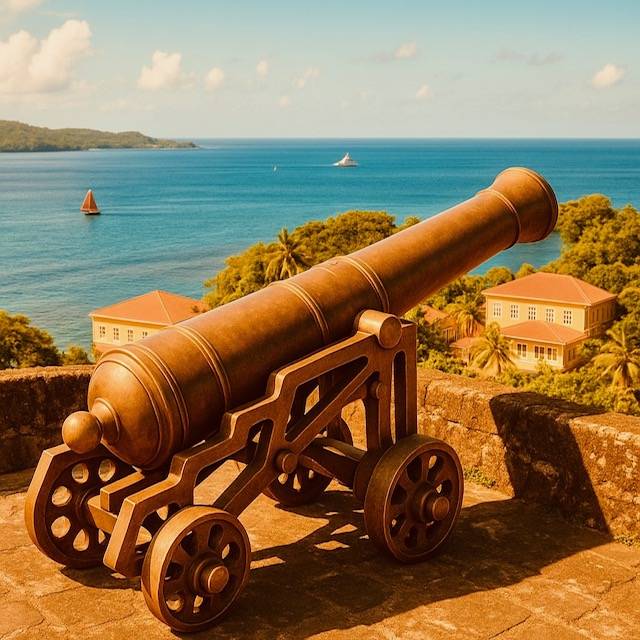Source: Britannica

Grenada, byname Isle of Spice, is an island country of the West Indies. It is the southernmost island of the north-south arc of the Lesser Antilles, lying in the eastern Caribbean Sea about 100 miles (160 km) north of the coast of Venezuela. Oval in shape, the island is approximately 21 miles (34 km) long and 12 miles (19 km) wide.
The southern Grenadines—the largest of which is Carriacou, about 20 miles (32 km) north-northeast, with an area of 13 square miles (34 square km)—are a dependency.
Head Of Government: Prime Minister
Capital: St. George’s
Population (2021 est.): 114,800
Head Of State: British Monarch, represented by Governor-General
Form Of Government: Constitutional monarchy with two legislative houses (Senate, House of Representatives)
The capital, St. George’s, on the southwest coast, is also the main port, having a fine natural harbour. Its picturesque pastel-coloured houses rise up the hillsides from the waterfront. The waterfront itself is known as the Carenage, as island schooners were once careened (beached for cleaning or repair) there. St. George’s is the yachting and charter-boat centre of the eastern Caribbean.
In 1974, Grenada attained independence within the Commonwealth and membership in the United Nations. It was the first of the six West Indies Associated States to do so.
Land Relief
Grenada is volcanic in origin, with a ridge of mountains running north and south—the steeper slopes to the west and a more gradual incline to the east and southeast. The highest point is Mount St. Catherine (2,757 feet [840 metres]) in the northern interior. The landscape is scenic, with deep, steep-sided valleys and about 10,000 acres (4,000 hectares) of forest.
Drainage and Soils
Several short, swiftly flowing streams supply towns and villages with clean piped water. Another source is Grand Etang, a lake in the crater of an extinct volcano at an elevation of 1,740 feet (530 metres). The fertile soils are chiefly volcanic, with some limestone in the north.
Climate
Temperatures are generally mild, averaging 82 °F (28 °C), and vary with altitude. Rainfall varies from 60 inches (1,500 mm) in coastal areas to over 150 inches (3,810 mm) in mountainous regions. The rainy season lasts from June to December. Although Grenada lies south of the usual hurricane track, major hurricanes struck in 1955, 1979, and 1980.
Plant and Animal Life
Grenada has a year-round growing season and a variety of tropical fruits, flowering shrubs, and ferns. Forests include teak, mahogany, saman (rain tree), and blue mahoe. Wildlife includes the mona monkey (introduced from West Africa), manicou (opossum), agouti, iguana, mongoose, turtles, and land crabs.
People
Most of the population is of African descent, with minorities of East Indians, Europeans, and mixed heritage. English is the official language, and a form of patois is spoken in some villages. Religions include Protestantism (nearly half), Roman Catholicism (over one-third), and small groups of Rastafarians and Jehovah’s Witnesses.
Economy
Agriculture and tourism are the main economic sectors, with growing contributions from fishing and agro-processing. Major exports include cocoa, bananas, nutmeg, and mace. Other products include coconut-based goods and tropical fruits. The government promotes staple vegetable production and is working to modernize fishing.
Manufacturing, Services, and Trade
Tourism is vital and supported by improved air and sea transport. Other industries include clothing, sugar milling, brewing, rum distilling, food canning, copra processing, and soapmaking. Grenada trades primarily with the U.S., Germany, Malaysia, the U.K., and Caribbean neighbours.
Transportation
Bus services connect towns and villages. An international airport at Point Salines opened in 1984. Pearl’s Airport and an airport on Carriacou provide regional flights. St. George’s harbour supports oceangoing vessels and yachts.
Government and Society
Grenada is a constitutional monarchy. The prime minister heads the elected House of Representatives, and the Senate is appointed. The governor-general represents the monarch.
Health and Welfare
Government hospitals and clinics provide free medical and dental care. Efforts exist to eradicate malaria and rabies.
Education
Primary and secondary education is free but not compulsory. Grenada has vocational and technical schools, the St. George’s University School of Medicine, and a University of the West Indies campus.
Cultural Life
The Grenada National Museum in St. George’s showcases archaeology and history. Artists Elinus Cato and Canute Caliste gained international recognition. Newspapers and radio/TV broadcasting are widely available.
History
Grenada was sighted by Columbus in 1498. Initially inhabited by the Carib people, it resisted early colonization. The French established a settlement in 1650. Grenada was later ceded to Britain in 1763, briefly recaptured by France in 1779, and restored to Britain in 1783.
British Rule and Independence
Slavery was abolished in 1833. Grenada became the seat of the Windward Islands government in 1885. It joined the West Indies Federation in 1958, then became self-governing in 1967 and fully independent in 1974.
Modern Political Developments
A 1979 coup led by the New Jewel Movement installed Maurice Bishop as prime minister. In 1983, Bishop was overthrown and killed in another coup, leading to a U.S.-led invasion and restoration of constitutional rule. Democratic elections resumed in 1984.
Prime Ministers since 1984 include Herbert A. Blaize, Nicholas Braithwaite, Keith Mitchell, and Tillman Thomas. Key events include Hurricane Ivan in 2004, offshore banking reforms, and periodic changes in government leadership.